Stanford coursera Andrew Ng 机器学习课程第四周总结(附Exercise 3)
Posted
tags:
篇首语:本文由小常识网(cha138.com)小编为大家整理,主要介绍了Stanford coursera Andrew Ng 机器学习课程第四周总结(附Exercise 3)相关的知识,希望对你有一定的参考价值。
Introduction
Neural NetWork的由来
先考虑一个非线性分类,当特征数很少时,逻辑回归就可以完成了,但是当特征数变大时,高阶项将呈指数性增长,复杂度可想而知。如下图:对房屋进行高低档的分类,当特征值只有x1,x2,x3时,我们可以对它进行处理,分类。但是当特征数增长为x1,x2....x100时,分类器的效率就会很低了。
Neural NetWork模型
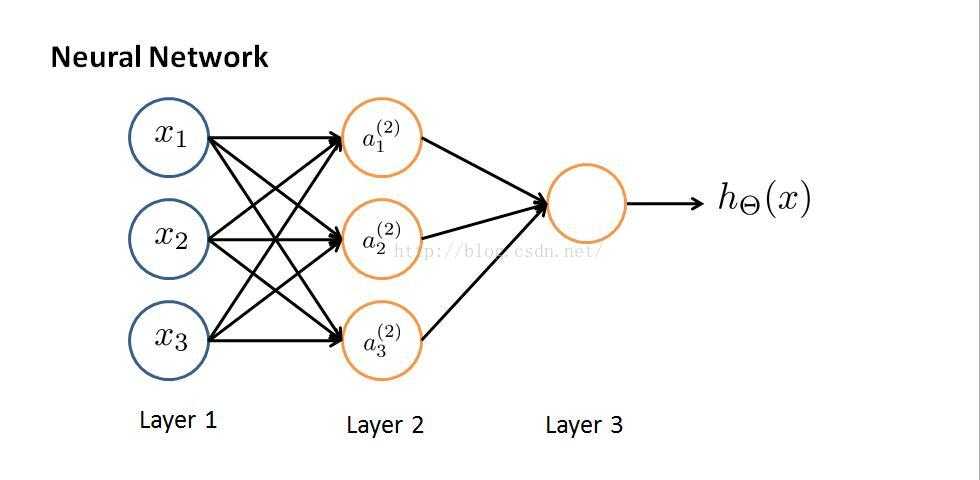
该图是最简单的神经网络,共有3层,输入层Layer1;隐藏层Layer2;输出层Layer3,每层都有多个激励函数ai(j).通过层与层之间的传递参数Θ得到最终的假设函数hΘ(x)。我们的目的是通过大量的输入样本x(作为第一层),训练层与层之间的传递参数(经常称为权重),使得假设函数尽可能的与实际输出值接近h(x)≈y(代价函数J尽可能的小)。
逻辑回归模型
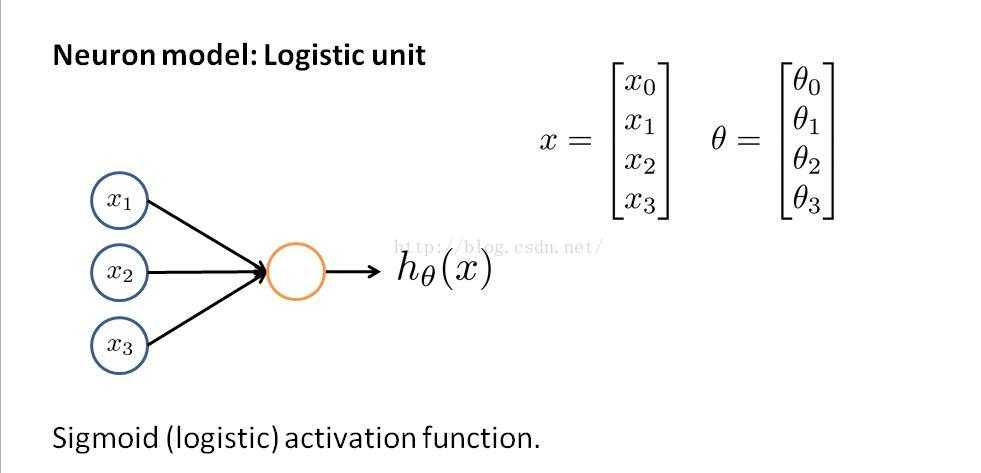
很容易看出,逻辑回归是没有隐藏层的神经网络,层与层之间的传递函数就是θ。
Neural NetWork
神经网络模型---正向传播

Cost function(代价函数)
Examples and intuitions
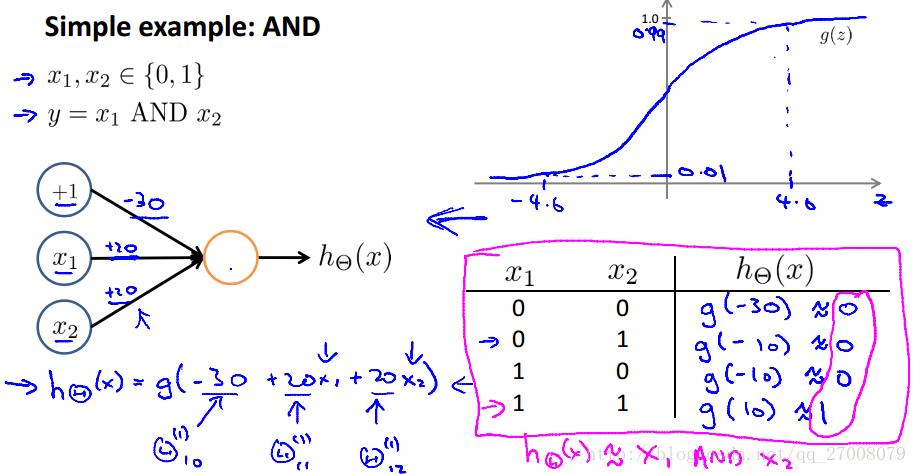
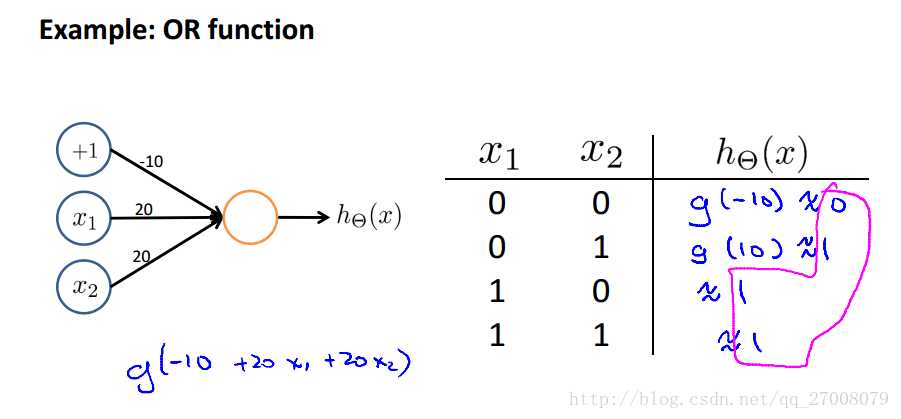
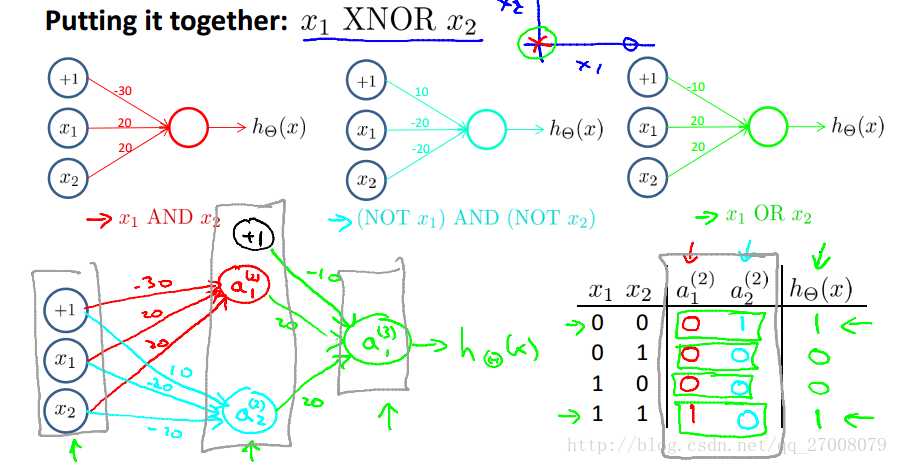
Multi-class classification
对于多分类问题,我们可以通过设置多个输出值来实现。

编程作业就是一个多分类问题——手写数字识别
输入的是手写的照片(数字0-9),5000组样本、每个像素点用20×20的点阵表示成一行,输入向量为5000×400的矩阵X,经过神经网络传递后,输出一个假设函数(列向量),取最大值所在的行号即为假设值(0-9中的一个)。也就是输出值y = 1,2,3,4,5.....10又有可能,为了方便数值运算,我们用10×1的列向量表示,譬如 y = 5,有

Exercises
这次的作业是用逻辑回归和神经网络来实现手写数字识别,比较下两者的准确性。
Logistic Regression
lrCostFunction.m
function [J, grad] = lrCostFunction(theta, X, y, lambda) %LRCOSTFUNCTION Compute cost and gradient for logistic regression with %regularization % J = LRCOSTFUNCTION(theta, X, y, lambda) computes the cost of using % theta as the parameter for regularized logistic regression and the % gradient of the cost w.r.t. to the parameters. % Initialize some useful values m = length(y); % number of training examples % You need to return the following variables correctly J = 0; grad = zeros(size(theta)); % ====================== YOUR CODE HERE ====================== % Instructions: Compute the cost of a particular choice of theta. % You should set J to the cost. % Compute the partial derivatives and set grad to the partial % derivatives of the cost w.r.t. each parameter in theta % % Hint: The computation of the cost function and gradients can be % efficiently vectorized. For example, consider the computation % % sigmoid(X * theta) % % Each row of the resulting matrix will contain the value of the % prediction for that example. You can make use of this to vectorize % the cost function and gradient computations. % % Hint: When computing the gradient of the regularized cost function, % there‘re many possible vectorized solutions, but one solution % looks like: % grad = (unregularized gradient for logistic regression) % temp = theta; % temp(1) = 0; % because we don‘t add anything for j = 0 % grad = grad + YOUR_CODE_HERE (using the temp variable) % theta_reg=[0;theta(2:size(theta))]; J = (-y‘*log(sigmoid(X*theta))-(1-y)‘*log(1-sigmoid(X*theta)))/m + lambda/(2*m)*(theta_reg‘)*theta_reg; grad = X‘*(sigmoid(X*theta)-y)/m + lambda/m*theta_reg; % ============================================================= grad = grad(:); end
oneVsAll.m
function [all_theta] = oneVsAll(X, y, num_labels, lambda) %ONEVSALL trains multiple logistic regression classifiers and returns all %the classifiers in a matrix all_theta, where the i-th row of all_theta %corresponds to the classifier for label i % [all_theta] = ONEVSALL(X, y, num_labels, lambda) trains num_labels % logistic regression classifiers and returns each of these classifiers % in a matrix all_theta, where the i-th row of all_theta corresponds % to the classifier for label i % Some useful variables m = size(X, 1); n = size(X, 2); % You need to return the following variables correctly all_theta = zeros(num_labels, n + 1); % Add ones to the X data matrix X = [ones(m, 1) X]; % ====================== YOUR CODE HERE ====================== % Instructions: You should complete the following code to train num_labels % logistic regression classifiers with regularization % parameter lambda. % % Hint: theta(:) will return a column vector. % % Hint: You can use y == c to obtain a vector of 1‘s and 0‘s that tell you % whether the ground truth is true/false for this class. % % Note: For this assignment, we recommend using fmincg to optimize the cost % function. It is okay to use a for-loop (for c = 1:num_labels) to % loop over the different classes. % % fmincg works similarly to fminunc, but is more efficient when we % are dealing with large number of parameters. % % Example Code for fmincg: % % % Set Initial theta % initial_theta = zeros(n + 1, 1); % % % Set options for fminunc % options = optimset(‘GradObj‘, ‘on‘, ‘MaxIter‘, 50); % % % Run fmincg to obtain the optimal theta % % This function will return theta and the cost % [theta] = ... % fmincg (@(t)(lrCostFunction(t, X, (y == c), lambda)), ... % initial_theta, options); % initial_theta = zeros(n + 1, 1); options = optimset(‘GradObj‘, ‘on‘, ‘MaxIter‘, 50); for c = 1:num_labels all_theta(c,:) = fmincg (@(t)(lrCostFunction(t, X, (y == c), lambda)), initial_theta, options); end % ========================================================================= end
predictOneVsAll.m
function p = predictOneVsAll(all_theta, X) %PREDICT Predict the label for a trained one-vs-all classifier. The labels %are in the range 1..K, where K = size(all_theta, 1). % p = PREDICTONEVSALL(all_theta, X) will return a vector of predictions % for each example in the matrix X. Note that X contains the examples in % rows. all_theta is a matrix where the i-th row is a trained logistic % regression theta vector for the i-th class. You should set p to a vector % of values from 1..K (e.g., p = [1; 3; 1; 2] predicts classes 1, 3, 1, 2 % for 4 examples) m = size(X, 1); num_labels = size(all_theta, 1); % You need to return the following variables correctly p = zeros(size(X, 1), 1); % Add ones to the X data matrix X = [ones(m, 1) X]; % ====================== YOUR CODE HERE ====================== % Instructions: Complete the following code to make predictions using % your learned logistic regression parameters (one-vs-all). % You should set p to a vector of predictions (from 1 to % num_labels). % % Hint: This code can be done all vectorized using the max function. % In particular, the max function can also return the index of the % max element, for more information see ‘help max‘. If your examples % are in rows, then, you can use max(A, [], 2) to obtain the max % for each row. % [maxx, p]=max(X*all_theta‘,[],2); % ========================================================================= end
Training Set Accuracy: 95.100000
下面是以三层bp神经网络处理的手写数字识别,其中权重矩阵已给出。
predict.m
function p = predict(Theta1, Theta2, X) %PREDICT Predict the label of an input given a trained neural network % p = PREDICT(Theta1, Theta2, X) outputs the predicted label of X given the % trained weights of a neural network (Theta1, Theta2) % Useful values m = size(X, 1); num_labels = size(Theta2, 1); % You need to return the following variables correctly p = zeros(size(X, 1), 1); % ====================== YOUR CODE HERE ====================== % Instructions: Complete the following code to make predictions using % your learned neural network. You should set p to a % vector containing labels between 1 to num_labels. % % Hint: The max function might come in useful. In particular, the max % function can also return the index of the max element, for more % information see ‘help max‘. If your examples are in rows, then, you % can use max(A, [], 2) to obtain the max for each row. % X = [ones(m, 1) X]; temp=sigmoid(X*Theta1‘); temp = [ones(m, 1) temp]; temp2=sigmoid(temp*Theta2‘); [maxx, p]=max(temp2, [], 2); % ========================================================================= end
Training Set Accuracy: 97.520000
注意事项
1.X = [ones(m, 1) X];是确保矩阵维度一致。X0就是一行1
2.正则化时theta0要用0替代,处理如theta_reg=[0;theta(2:size(theta))];
以上是关于Stanford coursera Andrew Ng 机器学习课程第四周总结(附Exercise 3)的主要内容,如果未能解决你的问题,请参考以下文章
Stanford coursera Andrew Ng 机器学习课程第二周总结(附Exercise 1)
Stanford CS229 Machine Learning by Andrew Ng
Coursera - Machine Learning, Stanford: Week 5
Coursera - Machine Learning, Stanford: Week 11

